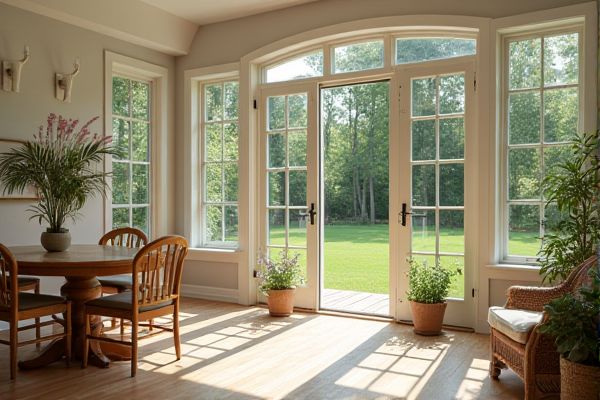
Sunrooms offer a climate-controlled space with large windows to enjoy sunlight year-round, while verandas provide an open-air, covered area ideal for relaxation and social gatherings. Explore this article to understand which option best suits Your lifestyle and enhances Your home's outdoor living experience.
Table of Comparison
| Feature | Sunroom | Veranda |
|---|---|---|
| Definition | Enclosed, glass-walled room attached to a house | Open or partially covered porch attached to the exterior |
| Climate Control | Insulated, can be heated or cooled | Uninsulated, exposed to external weather |
| Usage | Year-round sun exposure and indoor relaxation | Outdoor leisure and social gatherings |
| Construction | Glass panels, framed structure | Wood or metal framing with open sides |
| Cost | Higher due to enclosure and HVAC needs | Lower, simpler structure |
| Maintenance | Requires cleaning of glass and climate systems | Regular outdoor upkeep, painting |
| Property Value | Increases value with added living space | Enhances curb appeal and outdoor living |
Understanding Sunrooms: Definition and Features
Sunrooms are enclosed, glass-structured extensions attached to a house, designed to capture natural light and offer year-round outdoor views. They typically feature insulated windows, climate control, and durable materials to provide comfort regardless of weather conditions. Unlike verandas, sunrooms function as fully usable interior spaces, blending outdoor ambiance with indoor protection.
What is a Veranda? Key Characteristics
A veranda is an open-air porch or platform, often roofed and extending along the outside of a house, providing a shaded space for relaxation and socializing. Key characteristics include its partial enclosure with railings or low walls, an emphasis on outdoor living, and its integration into the home's architecture to enhance curb appeal. Unlike a sunroom, a veranda is not fully enclosed with glass, allowing fresh air and direct outdoor exposure.
Sunroom vs Veranda: Structural Differences
A sunroom is an enclosed structure with glass walls and roof panels designed to capture sunlight while providing protection from weather, making it usable year-round. A veranda, by contrast, is an open or partially enclosed platform attached to the exterior of a house, often featuring a roof but lacking full enclosure. Understanding these structural differences helps you decide between a sun-drenched indoor space and an airy outdoor extension for your home.
Comparing Uses: Sunroom vs Veranda
A sunroom offers a climate-controlled, enclosed space allowing year-round enjoyment of natural light, making it ideal for indoor relaxation, gardening, or a home office. In contrast, a veranda provides an open or partially covered outdoor area, perfect for social gatherings, outdoor dining, or simply experiencing fresh air while staying shaded. Your choice depends on whether you prioritize protected comfort or open-air versatility in your living space.
Climate Control: Sunroom vs Veranda
Sunrooms offer superior climate control with insulated walls, windows, and often heating or cooling systems, allowing year-round usability regardless of external weather conditions. Verandas are typically open or semi-enclosed, exposing you to outdoor temperatures, making them less effective for maintaining a consistent indoor climate. Choosing a sunroom provides enhanced comfort by protecting against extreme heat, cold, and moisture while still letting natural light in.
Aesthetic Appeal: Design and Style Options
Sunrooms offer sleek, modern designs with extensive glass panels that maximize natural light and create a seamless indoor-outdoor feeling, enhancing contemporary home aesthetics. Verandas typically feature classic architectural elements such as columns, railings, and open-air spaces that complement traditional or rustic home styles while adding charm and curb appeal. Both sunrooms and verandas provide customizable design options, but sunrooms emphasize light-filled interiors whereas verandas focus on outdoor leisure with structural character.
Cost Comparison: Sunroom vs Veranda
A sunroom typically costs between $15,000 and $70,000 depending on size, materials, and customization, while verandas range from $8,000 to $25,000, mainly influenced by design complexity and materials used. Sunrooms, enclosed with glass panels, often require more expensive construction and insulation compared to open-air verandas that need simpler framing and roofing. Homeowners seeking year-round usability should budget higher for sunrooms due to HVAC and glazing costs, whereas verandas offer a cost-effective option for covered outdoor space.
Maintenance Requirements: Which is Easier?
Sunrooms typically require less maintenance than verandas because they are enclosed structures, protecting interior surfaces from weather-related damage such as moisture, dirt, and pests. Verandas, being open or semi-open outdoor spaces, need regular upkeep like cleaning, painting, and treating wood or metal components to prevent decay and rust. Choosing a sunroom minimizes ongoing maintenance efforts due to its weather-resistant materials and sealed environment.
Value Addition to Home: Sunroom vs Veranda
A sunroom typically adds more value to your home by providing an enclosed, climate-controlled space usable year-round, enhancing both comfort and livable square footage. Verandas offer aesthetic charm and outdoor relaxation but lack insulation, limiting their functional value in colder months. Homebuyers often favor sunrooms for their versatility and ability to increase property appraisals.
Choosing the Right Option: Factors to Consider
When choosing between a sunroom and a veranda, consider factors such as climate, intended use, and maintenance requirements. A sunroom offers enclosed, year-round comfort with ample natural light, ideal for colder regions or extended indoor use. Your decision should also weigh the structural complexity and budget, as verandas typically provide open-air relaxation with simpler construction and lower costs.
 homyna.com
homyna.com